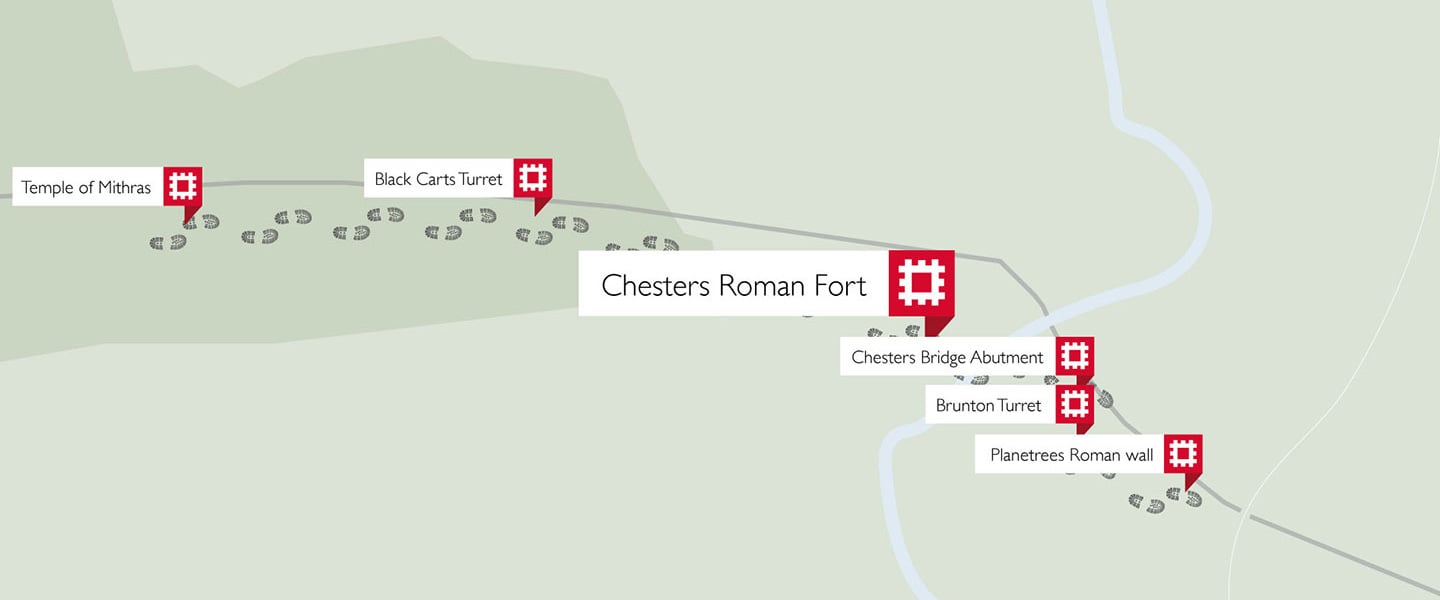The Chesters Roman Trail
A relaxing and tranquil section of Hadrian's Wall country, located next to the North Tyne River. It's not hard to understand why the Romans settled here. From bath houses to bridges, turrets to a Roman well, the Chesters Roman Trail is bursting with historic stories, monuments and remains.

Picture Perfect
Six miles from the market town of Hexham, the Chesters Roman Fort area is a picture-perfect heritage location on the line of Hadrian's Wall, nestled in the valley of Chollerford next to the North Tyne river. From bath houses to bridges, turrets to a Roman well, the Chesters Roman Trail is bursting with historic stories, monuments and remains ready to discover, and Roman engineering to admire.
Temple of Mithras, Carrawburgh
Step into a fascinating temple dedicated to the eastern god, Mithras. Founded in the third century, this free historic site also contains facsimilies of altar stones found during excavations. Nearby, but no longer visible was the shrine of the water nymph, Coventina.
In 1867, lead miners discovered Coventina's Well. John Clayton, lawyer, Newcastle town clerk and antiquarian who lived at the nearby Chesters estate, arranged an excavation and the well, on the site of a spring, produced more than 13,000 coins, at least 22 altars, vases, incense burners, pearls and brooches. They were gifts to the water goddess Coventina. Some of these gifts can be found on display inside the Museum at Chesters Roman Fort.
Black Carts Turret
West of Chesters Roman Fort, you will find a fine stretch of Hadrian's Wall, almost 500 metres long, climbing up to Limestone Corner. Here you'll find a turret, which seems to have continued in occupation well into the fourth century. The term 'carts' within the name is derived from the old English word ceart, which means rocky and rough.
Chesters Roman Fort
Chesters Roman Fort is the best-preserved Roman cavalry fort in Britain. You can see what life would have been like 2,000 years ago at one of the Empire’s northern outposts.
Wander round the officers' quarters and explore the well-preserved baths and steam room. You can also discover an amazing collection of Roman objects and inscriptions, found here and along the Wall, in our museum.
What you can see of the fort today is the result of the excavations by John Clayton. His passion for archaeology played a vital role in the preservation of the Roman sites on Hadrian’s Wall in the Victorian era.
Chesters cavalry fort straddles the Wall and housed a garrison of 500 troops for around 300 years. Today you can see all four principal gates, the headquarters building and courtyard, hall and regimental shrine. Plus, don't miss the ruins of an elaborate and luxurious commandant's house.
Chesters Bridge Abutment
Across the river from Chesters Roman Fort lies the east abutment of the bridge over the North Tyne. A pier embedded in this abutment probably formed part of the Hadrianic bridge. This is thought to have had ten stone piers supporting a timber superstructure carrying a walk across the river.
The position of the robbed east abutment of the bridge and a section of the paved riverbed can be seen in the bottom of the later tower. The visible abutment lay on the east side of the second bridge, which was built in the early third century. A gate tower, the basement of which survives, gave access to the bridge consisting of three stone arches.
Many carved stones from the superstructure of this bridge remain on the site. In the later Roman period a water channel serving a mill south of the bridge, was led through the tower basement.
Brunton Turret
Eastwards from Chesters Bridge and a few yards from the modern road lies Brunton Turret (26b). This still stands nearly 8.5 feet high. From its western side the Wall runs built to the original specification, 10 Roman feet thick. On the east side, a much narrower wall, 6 feet thick, rides up over the turret's wing wall.
Planetrees Roman Wall
Half a mile to the east of Brunton Turret is a short length of Wall at Planetrees. Here you can find a 15-metre length of narrow Wall on broad foundations, reflecting a change of policy concerning the thickness of the Wall during construction. It is clear that the soldiers laying the Wall's foundations had progressed quicker than the builders of the superstructure as the foundations continue on past the point of reduction. Interestingly the foundation builders also appear to have laid the drain, most of which is incorporated into the narrow wall.